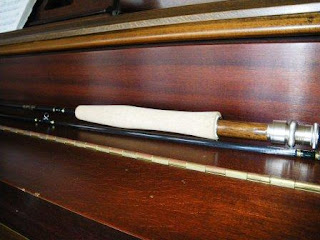With the splining of the rod done and the blank well marked it is time to assemble the reel seat.
The seat I am using on this rod came in five pieces, six if you count the tightening nut.
Make sure you completely understand how it goes together before getting out the epoxy. Practise a few times and make note of the order in which the pieces need to be put in place. Also make special note of what goes on from the front and what goes on from the back. You only get one shot at this.
When you are ready prepare the wood insert by lightly sanding only the parts that will be glued. Don't get careless- sand only the parts that will be hidden by hardware. Using a bit of emery paper or fine sandpaper also rough up the metal parts that will be in contact with the epoxy. Remember - only the parts that are hidden should be scuffed up.
Mixing the epoxy for finally gluing the reel seat together is another of those simple things that must be done perfectly to ensure success.
Epoxy is a co-polymer, which just means made of two chemicals. The two parts are called the hardener and the resin. In consumer applications these two parts are mixed together in equal proportions.
In practise I use a piece of tinfoil wrapped around a bit of cardboard as a mixing surface. Plastic coffee stir-sticks work well as a mixing tool and also double as great applicators for epoxy.
You can use syringes to ensure accurate measurement of the amounts to mix or you can pour out a drop of each chemical to about the size of a quarter. Both will work but accuracy is always better if you have the option.
Mix the components together gently for about two minutes. When the mixture is of a smooth even colour it is ready for use. A little goes a long way so be conservative when you apply it. It creates a very strong bond and the waterproof varieties are excellent for all rod building applications.
Epoxy is very difficult to clean up after it has cured. Be cautious about touching anything if you might have epoxy on your hands from the mixing or application process. I keep a few rags handy and wipe my hands carefully after every process from mixing to gluing.
Here is a good tip - plain white vinegar works well to clean up epoxy while you are working with it, even if the epoxy is starting to set and gets a bit sticky, vinegar will work.
Acetone is another thing that works very well but be careful about using it around the wooden part of your reel seat as it will ruin the finish. Acetone fumes are very unpleasant so be careful.
The best way to keep the wood looking great is to not get any epoxy where you don't want it.
Oh yeah, stick to the formula - 1:1 hardener to resin. More hardener won't make the epoxy harder. It will make it sticky and never able to set up or cure. Then you will have a real mess that is almost impossible to clean up and end up throwing away a $50.00 reel seat.
All that being said, my reel seat went together well and next time its Part 3-Attaching the Reel Seat to the Blank.
Labels: avoid problems with epoxy, building a fly rod, Cleaning up epoxy, Custom Fly Rod, How to build a fly rod, how to mix epoxy, Reel Seat













